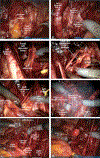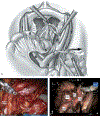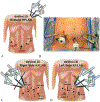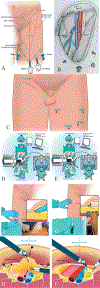Robot assisted lymphadenectomy in urology: pelvic, retroperitoneal and inguinal
- PMID: 28009144
- PMCID: PMC9134864
- DOI: 10.23736/S0393-2249.16.02823-X
Robot assisted lymphadenectomy in urology: pelvic, retroperitoneal and inguinal
Abstract
Lymph node dissection represents an essential surgical step in the treatment of the most commonly treated urological cancers. The introduction of robotic surgery has lead to the possibility of treating these diseases with a minimally invasive surgical approach, but the surgical principles of open surgery need to be carefully respected in order to achieve comparable oncological results. Therefore, the robotic approach to urological cancers must include a carefully performed lymph node dissection when indicated. In the current manuscript we reviewed the current indications and extensions of lymph node dissection in prostate, bladder, testicular, upper urinary tract, renal and penile cancers respectively, with a special focus on the state of the art surgical technique for each procedure.
Conflict of interest statement
Figures






References
-
- Guillonneau B, Cappèle O, Martinez JB, Navarra S, Vallancien G. Robotic assisted, laparoscopic pelvic lymph node dissection in humans. J Urol 2001;165:1078–81. - PubMed
-
- Suardi N, Larcher A, Haese A, Ficarra V, Govorov A.Buffi NM, et al.; EAU Young Academic Urologists-Robotic Section. Indication for and extension of pelvic lymph node dissection during robot-assisted radical prostatectomy: an analysis of five European institutions. Eur Urol 2014;66:635–43. - PubMed
-
- Salminen AP, Jambor I, Syvanen KT, Bostrom PJ. Update on novel imaging techniques for the detection of lymph node metastases in bladder cancer. Minerva Urol Nefrol 2016;68:138–49. - PubMed
-
- Heidenreich A, Bastian PJ, Bellmunt J, Bolla M, Joniau S, van der Kwast T, et al. EAU guidelines on prostate cancer. part 1: screening, diagnosis, and local treatment with curative intent-update 2013.; European Association of Urology. Eur Urol 2014;65:124–37. - PubMed
-
- National Comprehensive Cancer Network, Prostate cancer guideline version 1.2015; [Internet]. Available from: http://www.nccn.org/professionals/physician_gls/pdf/prostate.pdf. Latest NCCN guideline for PCa [cited 2016, Nov 30].
Publication types
MeSH terms
Grants and funding
LinkOut - more resources
Full Text Sources
